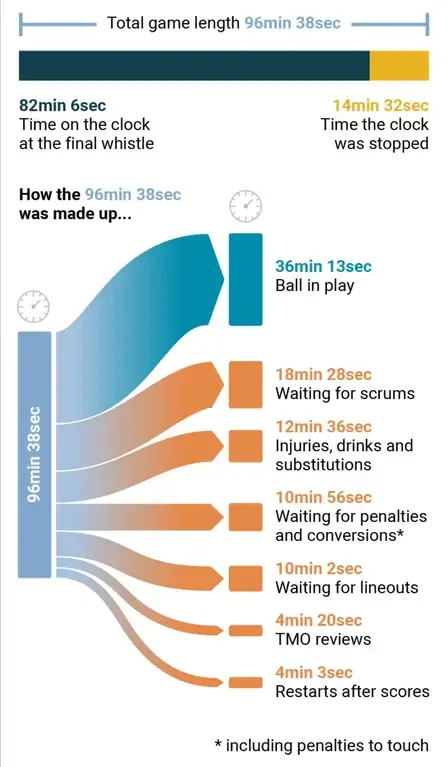At the weekend, or spread across your social media, you may have reference to an opinion piece in The Times about How To Speed Up Rugby based on a previous piece when Lawrence Dallaglio selected England v Wales (rather than Scotland v France) as “slow and painful to watch.” The linked piece contains a summary of the first one, and The Times paywall only lets you read one piece per day.
In the linked article there’s a graphic, that is also at the top of this column, showing how the time was spent during the match. Various people, some of whose opinions I respect, some I don’t, weigh in with suggestions for speeding up the game. People take aim at the resetting a scrum process, and the times when the laws say set a scrum, and introduce the concept of a “tap-only penalty.” That is, you have to take the tap and play option, you can’t kick directly to touch or take a shot at goal. They talk about not having a scrum for various minor offences at the lineout if the other team gain possession.
Honestly, a lot of these are quite interesting and worth thinking about. Have at it below!
Some dodgy commentary
Lineout time
But they bemoan the length of time lost to “waiting for lineouts” – 10 minutes (and 2 seconds) in this particular match. They don’t mention that’s for 28 lineouts, which gives you an average of <22 seconds per lineout. I think that’s pretty good. I’ve previously suggested a clock on lineouts of 30 seconds and you didn’t chivvy them about having a huddle, if they wanted one, they couldn’t do as much moving. It looks like they can have a huddle, do some moving and still get it done in under 30 seconds. Of course I don’t know what “waiting for a lineout” means and it might not be quite the same as my 30s clock which runs from when the referee gives the mark to when the ball is thrown in, but it’s probably much of muchness.
Scrum Time
You look at 18 minutes 28 seconds “waiting for scrums” and think that’s awful. But for 18 scrums – a very high number for test matches these days, that’s just over a 1 minute each. That’s probably too slow, but we’ve all seen matches where it’s more like 5 minutes per scrum. I quite like the idea that for a lot of offences that currently earn a penalty, you award a tap-only kick. That keeps scrums in the game, does away with endless resets, but still stops the scrum at times when it’s potentially dangerous. If you keep a full penalty, possibly adding a card for a deliberate offence, for deliberately destabilising the scrum, you encourage teams to keep it together when being pushed backwards because the escalation from “tap only” to full penalty, possibly with a card, is much harsher than “well we’re going to give up a penalty anyway.”
Oops
You aren’t my stats class. But just looking at these raw data, this match looked bad. Dallaglio may have hated watching it. But once you look at the rest of the data, I think he rather was being just a grumpy old man. Maybe the fact that England really didn’t play well had something to do with that.
Quick Summary of Main Talking Points
If you don’t want to read the piece, here’s a quick summary:
- Quick taps for maul turnovers in open play, forward passes and crooked throws at lineouts (thus fewer scrums).
- 30s timer for lineout (that sounds familiar). There is some very ill-informed commentary about how long players take in “long meetings about setting up complex moves for lineouts”.
- Shorter timers for the conversion and penalty kick timers.
- No resets for scrums, one shot and various rules about who gets the tap-penalty.
- Change the TMO requirement to “most likely” than “clear evidence to overturn” (this was from a Scottish commenter who was still moaning).
- Change the 5s rule on rucks to start when the carrier places the ball. Because you can’t set the caterpillar ruck, more passes, fewer box kicks.
- It shouldn’t be a penalty if you get pushed back in the scrum – this is correct but too often the team going backwards goes up, down or in.


